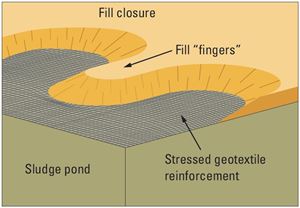Blog Bite 2: Sludge Pond Closure Using Geotextile Reinforcement
By Brendan Swifte

Welcome to our blog space where we share our insights and experiences in civil engineering and geosynthetics. We feature bite-sized articles for quick and easy consumption
For sludge ponds with low bearing capacity that have come to the end of their working life, a proven closure solution is the use of a multi-functional geotextile reinforcement layer across the sludge pond, followed by placement of fill material.
We explore the engineering that drives the use of this solution via six simple steps over 3 bite-sized pieces.
In our second bite, we consider the design process for a TenCate reinforcement geotextile solution.
Bite #2. SLUDGE POND CLOSURE USING GEOTEXTILE REINFORCEMENT
Many industries (particularly the mining sector) use storage ponds to contain sludge or sediments. As these ponds become full, a decision is required whether to extend their lives or to close and reclaim them.
We have covered Steps 1 and 2 on knowing the details of the sludge, the characteristics of the cover materials and construction equipment available at site. Let’s move on to the next two steps.
Step 3: Pond Dimensions
The pond dimensions are a simple check on how the geosynthetic reinforcement layer can be supplied to site in a way to maximise installation efficiencies ie. the pond dimensions will influence the construction details.
There are two common construction techniques:
- Rolls of geotextile are supplied to site and installed across the pond surface. To minimise wastage, roll dimensions may be selected to suit the specific pond. The geotextile rolls are pulled across the pond to form a continuous reinforcement layer. Consideration needs to be given to number of reinforcement layers and overlaps should settlement be expected.
- Geotextile panels can be created by sewing rolls into panels (either on-site or in the factory) to allow pulling or floating across the pond as a single layer.

Factory-sewn panels achieve much higher seam strengths as compared to stitching on-site.
Step 4: Design
The design will confirm the strength grade used for the reinforcement layer. The finger berm dimensions (and the spacings between them) can be confirmed through the design process.
Tension membrane principles are used for the design process. There are several papers that outline a suggested design process for this application, and established design software can also be used to check on the local and global failure modes.
- Stabilization of very soft clay using geofabric :
Bengt B.Broms (1987) - Design and construction of geosynthetic reinforced lagoon caps :
D.B. Andrews and G.N. Richardson (1999) - Reinforcement design for construction of cover soil over soft sludge :
R.D. Espinoza and P.J. Sabatini (2008) - Capping/Closure of sludge ponds :
S.M. Gale, A. Theroux, B. Lacina and J. Henderson (2008)


The interpretation of results can require experience as the sludge deforms under load. As cover material is placed, the sludge and geosynthetic layers displace, which applies stresses to the panel seams. If the sludge is very weak, larger overlaps or higher seam strengths may be required to accommodate larger settlement.
Stay on for the last bite-sized piece where we look at some tips around the handling and installation of a TenCate geotextile reinforced capping solution.
References:
- Geotextile Reinforced Sludge Pond Closures brochure
- High Strength Woven Geotextiles Used to Reinforce Oil Sands Tailings Pond Closure, Northern Alberta case study



